June 2022
Salama!
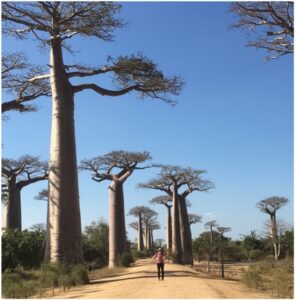 I’m actually writing this from the US, where I arrived a week ago! After seven long months in Madagascar, it was time to head home. On my way out I conducted a passive acoustic monitoring training workshop for CVB researchers, staff and other Malagasy stakeholders (NGOs, etc.) which was a lot of fun! It was great to see so much interest in the methods and I’m already talking to some folks about using my equipment to do further passive acoustic studies in the area & other parts of Mada! But I did lots of traveling on my way out, stopping at Kirindy dry forest (near Morondava on the west coast/Mozambique channel side of the island) & the ‘Avenue of Baobabs’ (pic to the right) and Andasibe, a few hours drive east of the capital city of Antananarivo. Andasibe is one of the only places you can see indri, the world’s largest living lemur. They are known as the “singing” lemurs because of their long, loud, and fairly haunting calls. Youtube indri call, you’ll see what I mean (pic below). AND I got super lucky because there was a 3-week-old baby indri when I went that I got to catch some glimpses of (he was wrapped tight around mom’s belly so it was hard to see).
I’m actually writing this from the US, where I arrived a week ago! After seven long months in Madagascar, it was time to head home. On my way out I conducted a passive acoustic monitoring training workshop for CVB researchers, staff and other Malagasy stakeholders (NGOs, etc.) which was a lot of fun! It was great to see so much interest in the methods and I’m already talking to some folks about using my equipment to do further passive acoustic studies in the area & other parts of Mada! But I did lots of traveling on my way out, stopping at Kirindy dry forest (near Morondava on the west coast/Mozambique channel side of the island) & the ‘Avenue of Baobabs’ (pic to the right) and Andasibe, a few hours drive east of the capital city of Antananarivo. Andasibe is one of the only places you can see indri, the world’s largest living lemur. They are known as the “singing” lemurs because of their long, loud, and fairly haunting calls. Youtube indri call, you’ll see what I mean (pic below). AND I got super lucky because there was a 3-week-old baby indri when I went that I got to catch some glimpses of (he was wrapped tight around mom’s belly so it was hard to see).
 After my travels I stayed in Tana (capital of Mada) with some other Fulbrighters who have been based there, and got to reacquaint myself with food that was not rice & beans, a true delicacy! I had been dreaming of Thai, Indian, sushi, falafel, tacos, etc… Some of that I had to wait until I got back to the US, so I had quite the food tour upon arrival to satisfy all my 7-month-old cravings. The route between Madagascar and the US is a real pain in the butt, not least of which because the only international flights that leave from Tana (capital city) do so at 1am. And my flight got delayed before I even got to the airport, so we didn’t end up taking off until 2am. Then it’s 11.5 hours to Paris, most of which is spent getting unsatisfying amounts of sleep in 30-minute increments because it is impossible for me to sleep on planes. Then 2-hour layover in Paris and 8 hour flight to NYC, where I collapsed into bed and slept for 12 hours. BUT I had an entire 4-seat middle row to myself, which is the traveling equivalent of basically winning the lottery, so I could actually get completely horizontal for that flight. A couple days of waking up at 3am ensued because of jet lag, but I think my Circadian rhythm has finally been reset by this point.
After my travels I stayed in Tana (capital of Mada) with some other Fulbrighters who have been based there, and got to reacquaint myself with food that was not rice & beans, a true delicacy! I had been dreaming of Thai, Indian, sushi, falafel, tacos, etc… Some of that I had to wait until I got back to the US, so I had quite the food tour upon arrival to satisfy all my 7-month-old cravings. The route between Madagascar and the US is a real pain in the butt, not least of which because the only international flights that leave from Tana (capital city) do so at 1am. And my flight got delayed before I even got to the airport, so we didn’t end up taking off until 2am. Then it’s 11.5 hours to Paris, most of which is spent getting unsatisfying amounts of sleep in 30-minute increments because it is impossible for me to sleep on planes. Then 2-hour layover in Paris and 8 hour flight to NYC, where I collapsed into bed and slept for 12 hours. BUT I had an entire 4-seat middle row to myself, which is the traveling equivalent of basically winning the lottery, so I could actually get completely horizontal for that flight. A couple days of waking up at 3am ensued because of jet lag, but I think my Circadian rhythm has finally been reset by this point.
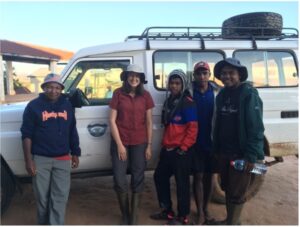 It was tough saying all my goodbyes to the team that has become family to me (that’s the crew to the left). But obviously good to get back and see my actual family (& friends) as well! Returning to my cat Lynie, who is basically my child, was also wonderful J. And now that I’m back in the US, I can begin analysis on all the recordings I have collected with the devices! I turn the sound files into spectrograms, which are basically 2-D image representations of sound, and then run machine learning models to detect lemur calls (like in the black box in the spectrogram below). I wrote more on those AI/ML methods earlier blog posts (Dec, Jan) as well, but in short I’m basically just giving the computer examples of what I want it to find, it which it “trains” itself with, and then searches for matches in other recordings.
It was tough saying all my goodbyes to the team that has become family to me (that’s the crew to the left). But obviously good to get back and see my actual family (& friends) as well! Returning to my cat Lynie, who is basically my child, was also wonderful J. And now that I’m back in the US, I can begin analysis on all the recordings I have collected with the devices! I turn the sound files into spectrograms, which are basically 2-D image representations of sound, and then run machine learning models to detect lemur calls (like in the black box in the spectrogram below). I wrote more on those AI/ML methods earlier blog posts (Dec, Jan) as well, but in short I’m basically just giving the computer examples of what I want it to find, it which it “trains” itself with, and then searches for matches in other recordings.

Once I find out which calls were detected on what devices, I can use that information along with the GPS coordinates of the devices and the estimated detection spaces around each recorder (how far away sounds can be heard by it) to model lemur distribution and range through the rainforest corridor I was surveying. So it’s exciting to be progressing to the next steps of the project, but of course sad to leave fieldwork behind for awhile and return back to real life… More updates on the analysis and final results in the coming months!
– Carly
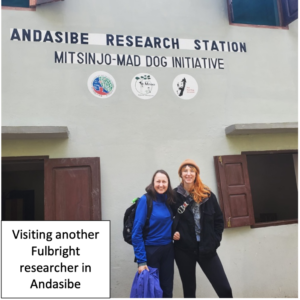

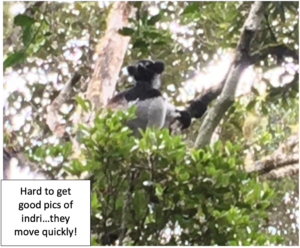
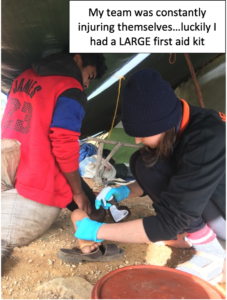



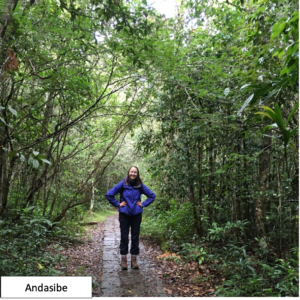

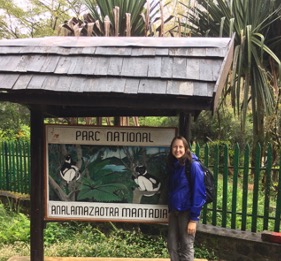

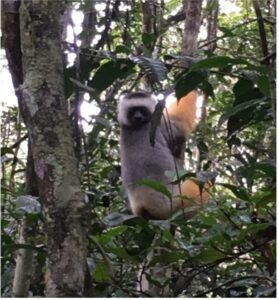
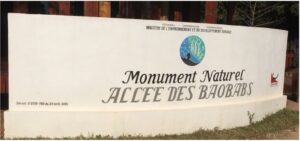



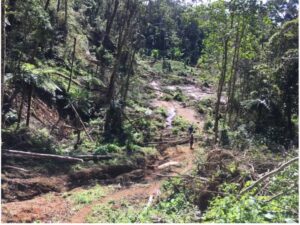
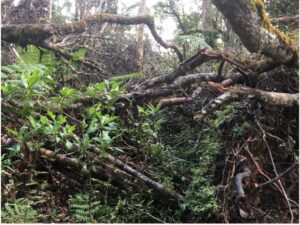
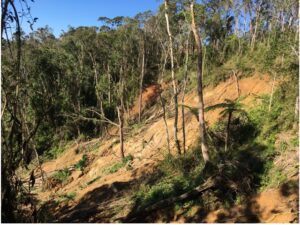
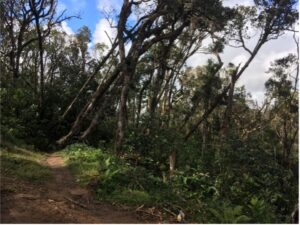
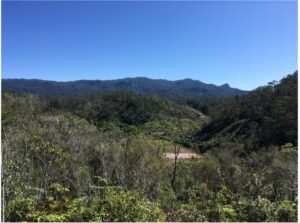
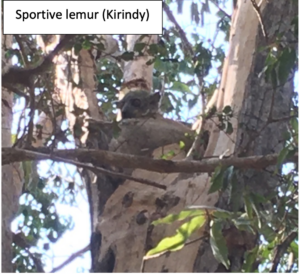

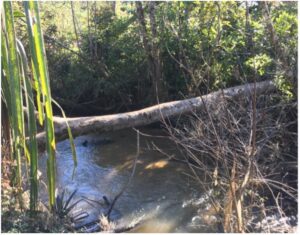
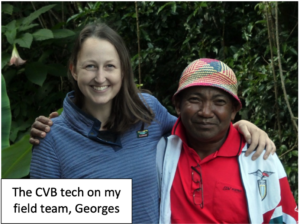



May 2022
Salama!
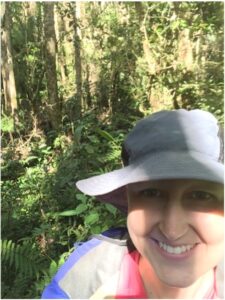
I’m back at Centre ValBio after another round of expeditions to retrieve the acoustic recorders that we put up in the forest. So far, we are 16 for 17, with one device seemingly lost to the cyclones. The entire area where it was put up had a landslide go through and there was nothing left standing, so that recorder is MIA. I somehow only have one more expedition left, which is crazy because it still feels like I just got here after 6 months! We’ll be picking up the last of the recorders and then I’ll be back to the US in mid-June. One more set of panic attacks about recorders being destroyed by the cyclones… Other notable moments from this last expedition – I ate it hard crossing a river and slamming into a big rock on my way down, so I’m sufficiently bruised all over. And the ghost that stole my shampoo awhile back seems to have returned and stolen my field hat this time around, which for someone as pale as me is basically a sentence of death-by-sunburn. Luckily, I am a type A, over-prepared, over-organized person and had another, so still alive, and do not currently resemble a tomato (“voatabia” – there’s your Malagasy word-of-the-day).
 It’s exciting that I’m starting to get data back though! I can’t do much analysis while still here in Madagascar, I have to wait until I get back to the US to run the machine learning models that automatically detect the lemur calls. The models require LOTS of computational power, and we need good connectivity to upload all the recordings from external hard drives to a cloud system. From my preliminary lookovers of the spectrograms (basically 2-D picture of sound) from the recordings, things are looking good though! In the example below, the ruffed lemur roar-shriek call (what I’m looking for in these recordings) is outlined in black. You basically give the model a bunch of examples of that call of interest, and it “trains” itself on them and then tries to find matching calls in the long-term recordings. Don’t ask what goes on under the hood though because I truly think it is actual magic. The magical models are very necessary as I’m going to end up with ~5TB of data, so going through all of that manually would take literal lifetimes.
It’s exciting that I’m starting to get data back though! I can’t do much analysis while still here in Madagascar, I have to wait until I get back to the US to run the machine learning models that automatically detect the lemur calls. The models require LOTS of computational power, and we need good connectivity to upload all the recordings from external hard drives to a cloud system. From my preliminary lookovers of the spectrograms (basically 2-D picture of sound) from the recordings, things are looking good though! In the example below, the ruffed lemur roar-shriek call (what I’m looking for in these recordings) is outlined in black. You basically give the model a bunch of examples of that call of interest, and it “trains” itself on them and then tries to find matching calls in the long-term recordings. Don’t ask what goes on under the hood though because I truly think it is actual magic. The magical models are very necessary as I’m going to end up with ~5TB of data, so going through all of that manually would take literal lifetimes.


I am also developing materials for a passive acoustics training workshop I’m leading here at the research station. I am leaving all the recorders and associated equipment here to facilitate future research, so I’m developing a guidebook and training materials for staff and researchers at Centre ValBio (CVB), the Madagascar forest department, Madagascar National Parks, and other NGOs working in the rainforest corridor region. I will luckily have Rija, a Malagasy graduate student I work with, to help me translate the materials into Malagasy & French (my conversational abilities are limited to very specific topics, like food, directions, and other things good to know to survive doing fieldwork).
Working with CVB and the other NGOs & government departments has been extremely helpful considering the logistical difficulties of this project and the remote areas we were trying to get to. It has also been amazing working with the local villages alongside the forest. The local guides we have worked with are so knowledgeable and expert navigators, they seriously have a map of like 50 square kilometers just in their heads. We’ve seen lots of illegal activities, like tavy (slash-and-burn agriculture), logging & mining which has been fairly depressing, so it’s refreshing to know and work with people who are invested in saving the forest.

Usual photo dump of bad iPhone 6 camera photos below (lol). That phone has been through just about everything, but I think it’ll finally be time to upgrade as an end-of-project present to myself. Crazy to think I’ll be home so soon, but happy I’ll be able to see my friends and family again who I’ve really been missing of late. But of course it will be bittersweet having to say goodbye to my field team, the CVB staff, and the beautiful Ranomafana area (picture of the “downtown” on left). It really has become like a second home to me, and I am so grateful for all the wonderful people I’ve met and places I’ve seen.
Until next time!
Carly
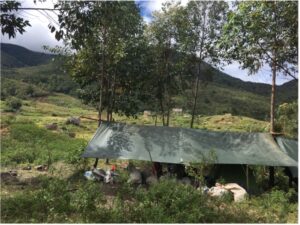

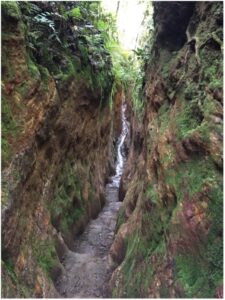
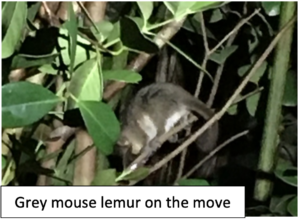
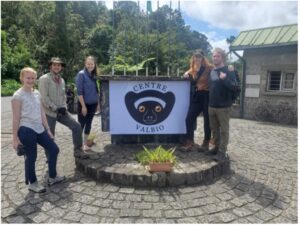

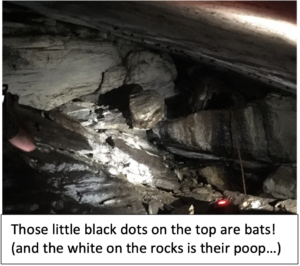
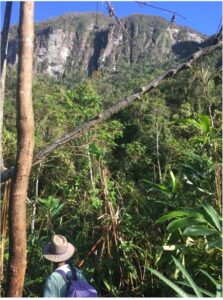

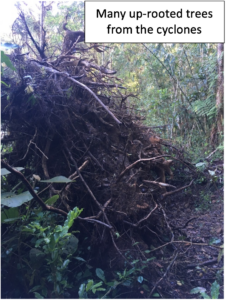
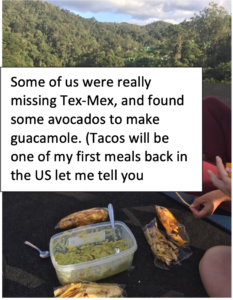

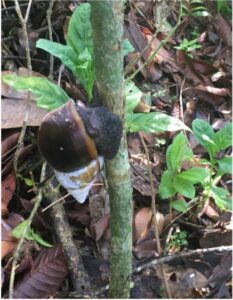
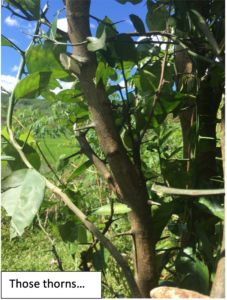
April 2022
Salama!
The past month I’ve continued the up-and-down rollercoaster of expeditions and dealing with the long-term effects of the 2 major cyclones that hit SE Madagascar in February. I’ll start with the good news though! We’re now in the stage of the project where we’re retrieving the audio recorders we deployed. This is exciting, because I can finally start to see the data, but anxiety-inducing, because we see if the recorders survived the cyclones. So far, we are 7 for 7 on recovering devices, which is great! But we’ve still got another 20 to go, so I’m still holding my breath…
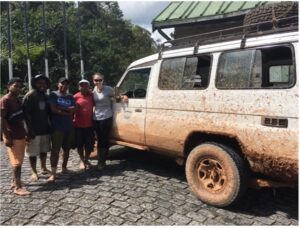
 For the not so good news, we’ve had to deal with worse road conditions to even get to the start of the trails that go to the forest, which for one day resulted in us hiking 32km in one day. Truly destroyed me, I think my legs are still in recovery, 2 weeks later… The team has had to dig the car out of mud, we’ve gotten pulled out of ditches by passing 4×4’s, and I’ve taken enough dramamine to knock out a small army at this point. (Point in case, for the last expedition it took us 5.5 hours to go 45km/28 miles. I call this road Satan’s highway).
For the not so good news, we’ve had to deal with worse road conditions to even get to the start of the trails that go to the forest, which for one day resulted in us hiking 32km in one day. Truly destroyed me, I think my legs are still in recovery, 2 weeks later… The team has had to dig the car out of mud, we’ve gotten pulled out of ditches by passing 4×4’s, and I’ve taken enough dramamine to knock out a small army at this point. (Point in case, for the last expedition it took us 5.5 hours to go 45km/28 miles. I call this road Satan’s highway).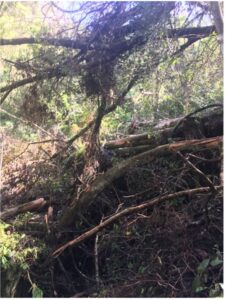

When we then finally get to the trailheads and hike to the forest, we’re dealing with fallen trees, past landslides, and other debris ruining forest trails, resulting in extensive bushwacking (the local guides expertly machete us through) to avoid obstacles and climb over tree trunks who seem determined to make me trip and fall as often possible. Of course, the Malagasy guides we’re with just hop and jump gracefully through this obstacle course from hell as if it’s a dang flat meadow of daisies. And the porters we use to carry all of our equipment & gear (men & women) can literally run up mountains while balancing 25kg (55lbs) bags on their heads, not needing water, not breaking a sweat, and breathing normally. Then here comes Carly, panting, sweating, cursing, and crying her way up… lol
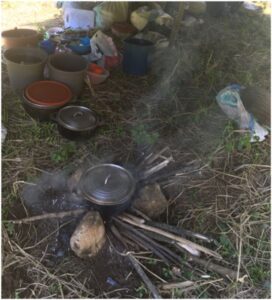 But at the end of each day, I always have our lovely camp to come back to and relax a bit in what my fellow lemur researcher Mariah and I have deemed “tent time” (see pic for my usual set-up!). We put up A-frames in tarp form over the tents, using branches with a fork in them and resting another one on top (step-by-step construction in photo dump below). The “kitchen” is an open fire with 3 rocks placed around it to rest the pot on, and thin strips of firewood are fed into the fire below. Water (“rano” in Malagasy) is ok to drink from the rivers here once it is boiled. There is of course constant cooking of rice, the lifeblood of Madagascar (“vary” in Malagasy, v important word to know here).
But at the end of each day, I always have our lovely camp to come back to and relax a bit in what my fellow lemur researcher Mariah and I have deemed “tent time” (see pic for my usual set-up!). We put up A-frames in tarp form over the tents, using branches with a fork in them and resting another one on top (step-by-step construction in photo dump below). The “kitchen” is an open fire with 3 rocks placed around it to rest the pot on, and thin strips of firewood are fed into the fire below. Water (“rano” in Malagasy) is ok to drink from the rivers here once it is boiled. There is of course constant cooking of rice, the lifeblood of Madagascar (“vary” in Malagasy, v important word to know here).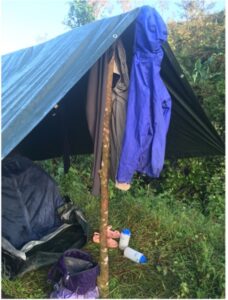
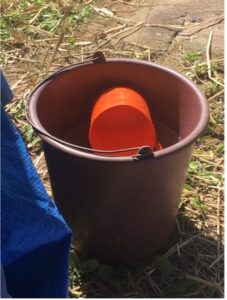
Our schedule basically follows the sun, we get up ~5:30am and go to bed by 8pm. This might sound crazy to you but let me tell you after all the hiking we do my body is begging for as much rest as it can get! Plus once the sun goes down… like what else is there really to do ya know. At the end of the day, I take a luxurious “shower” which is a bucket and a cup. Let me tell you that first shower back at the research station (Centre ValBio) after an expedition is absolute heaven. on. earth. euphoria.
Crazy to think I’ve been in Madagascar for 5 months already, time has really flown by! I’m in the homestretch now, 2 months to go until I return to the real world (ugh). But I’m really looking forward to seeing my family & friends back home in the near future.
Fingers crossed the rest of the recorders survived & recorded good data! Mandrapihaona (see you later)!
-Carly

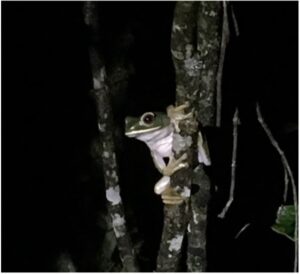

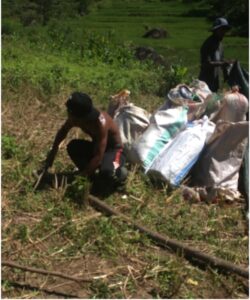
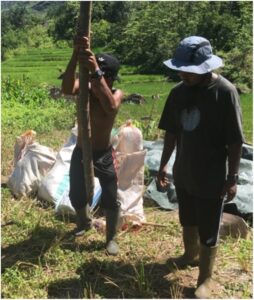
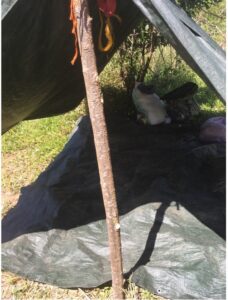
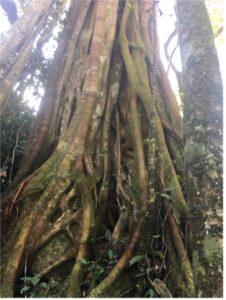


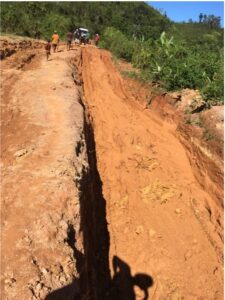
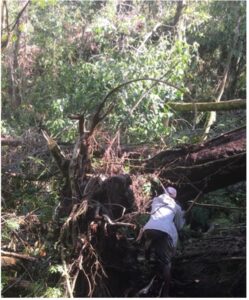
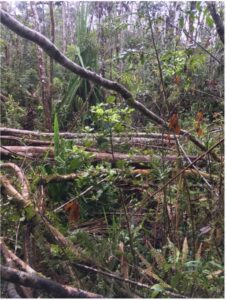
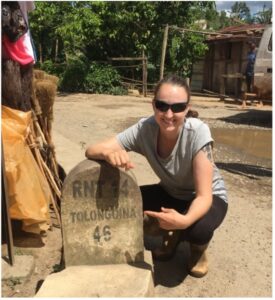
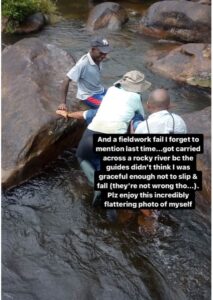
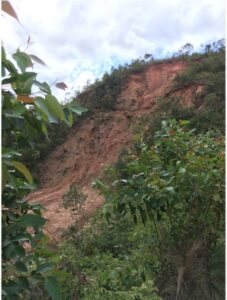
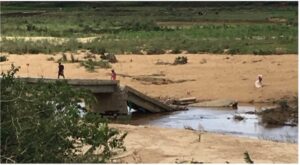

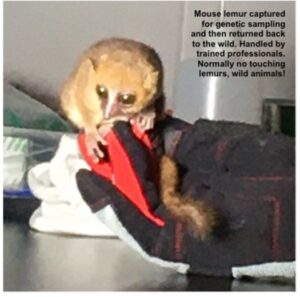
March 2022
Salama!
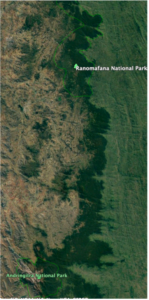 Last expedition turned into quite the whirlwind, literally and metaphorically. A couple days in, another cyclone hit southeastern Madagascar (Cyclone Emnati). It had been on track to hit more north of where we were going to be (about middle of the corridor – re-posting the map here) and that we would be ok to stay in the field. But then it changed course dramatically practically overnight (turning south towards us), and we didn’t have time to evacuate out by that time because of how far from a road we were. So, we hunkered down in a clay school building (pic below was our tent set-up inside) that somehow, magically, did not collapse and held strong. As you can see from the pics below, we passed the time having ourselves a little cyclone party making crepes, playing games (dominoes and cards, rummy especially, are popular here) and ok you caught me we drinking toaka. It’s like Malagasy moonshine. Disgusting, but I figured I’d need a buzz if I was going to get any sleep during a cyclone…
Last expedition turned into quite the whirlwind, literally and metaphorically. A couple days in, another cyclone hit southeastern Madagascar (Cyclone Emnati). It had been on track to hit more north of where we were going to be (about middle of the corridor – re-posting the map here) and that we would be ok to stay in the field. But then it changed course dramatically practically overnight (turning south towards us), and we didn’t have time to evacuate out by that time because of how far from a road we were. So, we hunkered down in a clay school building (pic below was our tent set-up inside) that somehow, magically, did not collapse and held strong. As you can see from the pics below, we passed the time having ourselves a little cyclone party making crepes, playing games (dominoes and cards, rummy especially, are popular here) and ok you caught me we drinking toaka. It’s like Malagasy moonshine. Disgusting, but I figured I’d need a buzz if I was going to get any sleep during a cyclone…
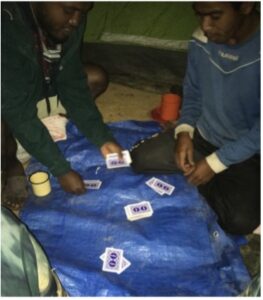
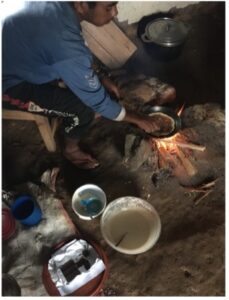 The cyclone luckily was not as strong as the first one (Batsirai) and in the area we were in, there wasn’t too damage so we were able to keep going with our fieldwork schedule 2 days after the cyclone. Shortly after that, I had a cut get infected (cleared now!). This is why I always bring basically an entire pharmacy with me… And to top it off I had a bad allergic reaction to some sort of microscopic biting insect/invertebrate/mite/thing so was on more meds for that. Yay tropical fieldwork!
The cyclone luckily was not as strong as the first one (Batsirai) and in the area we were in, there wasn’t too damage so we were able to keep going with our fieldwork schedule 2 days after the cyclone. Shortly after that, I had a cut get infected (cleared now!). This is why I always bring basically an entire pharmacy with me… And to top it off I had a bad allergic reaction to some sort of microscopic biting insect/invertebrate/mite/thing so was on more meds for that. Yay tropical fieldwork!
BUT all the recorders that were supposed to get put up, got put up, in the places they were supposed to so it was still a successful trip. Getting to those places was harder, as the trails in and around the forest were covered in debris, fallen trees, rockslides, etc. So we ended up having to do a lot more bushwhacking than normal. Luckily, the local guides are adept at using “kopkops” which are like a combination of axe and machete. We still got to see lots of beautiful views and cool animals – the highlight this trip was a tenrec (pic left), which is like the Malagasy version of a hedgehog. So weird-looking, so cool.
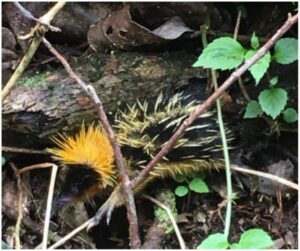
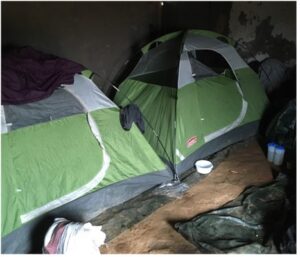 Despite all the twists and turns of this expedition, the daily routine still remained. We get up ~5:30am, eat breakfast and start hiking ~6:30. We’re either on a moving-camp hike or a deploying-recorder hike, depending on the day. Moving camps means we pack up and haul out to a different area of the corridor, which we do every 2-3 days, and then deployment days are when we put up the devices. Meals are pretty much the same everyday; breakfast is rice + egg, lunch is rice + beans, dinner is rice + hardy veggie’s (carrots, potatoes, etc.). You get the common thread – rice is king here in Mada. Sometimes there’s dried fish, which I find to be absolutely disgusting, but I like for the single reason that instead I get pomme frites (fried potatoes). Don’t ask me why that’s the alternative, I just know on dry fish days, I’m getting as close to french fries as I can get here. If we’re near a village the team will sometimes buy a chicken. But protein is hard because meat/dairy are perishable and we need foods that are going to last for weeks. As it is, we bring canned vegetables on long expeditions because eventually the fresh veggie’s go bad or we run out. And then sometimes we can find pineapples (mananasy in Malagasy), which grow everywhere here (the plants look so funny!)
Despite all the twists and turns of this expedition, the daily routine still remained. We get up ~5:30am, eat breakfast and start hiking ~6:30. We’re either on a moving-camp hike or a deploying-recorder hike, depending on the day. Moving camps means we pack up and haul out to a different area of the corridor, which we do every 2-3 days, and then deployment days are when we put up the devices. Meals are pretty much the same everyday; breakfast is rice + egg, lunch is rice + beans, dinner is rice + hardy veggie’s (carrots, potatoes, etc.). You get the common thread – rice is king here in Mada. Sometimes there’s dried fish, which I find to be absolutely disgusting, but I like for the single reason that instead I get pomme frites (fried potatoes). Don’t ask me why that’s the alternative, I just know on dry fish days, I’m getting as close to french fries as I can get here. If we’re near a village the team will sometimes buy a chicken. But protein is hard because meat/dairy are perishable and we need foods that are going to last for weeks. As it is, we bring canned vegetables on long expeditions because eventually the fresh veggie’s go bad or we run out. And then sometimes we can find pineapples (mananasy in Malagasy), which grow everywhere here (the plants look so funny!)
Next expedition will be a shorter one, but it’s the last deployment expedition before we start from the beginning and start going back to pick up the recorders! Exciting, because we’ll actually get to see the data, but nerve-wracking because I don’t know how they fared during TWO cyclones… They are in very waterproof cases and are cable locked onto the trees so I think they could survive the rain+wind, but if the tree they were attached to fell, well… that’s that. Hoping with all my worth they survived! But for now, time to put up the final four recorders on this next expedition, and then we’ll have covered this whole 150+ km corridor!
All the best,
Carly
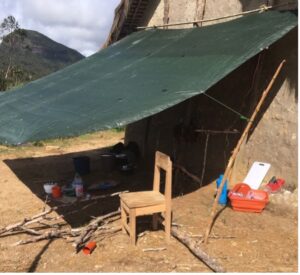
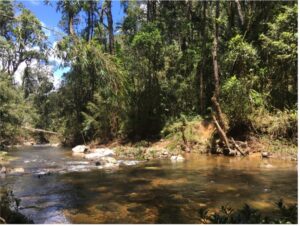
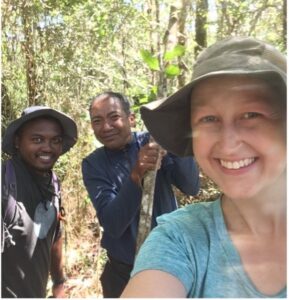
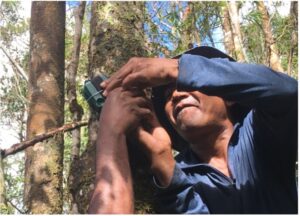
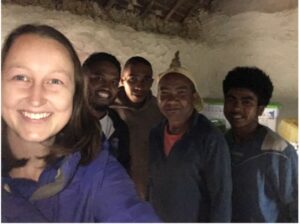
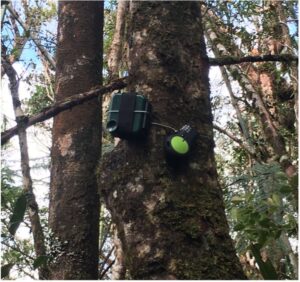

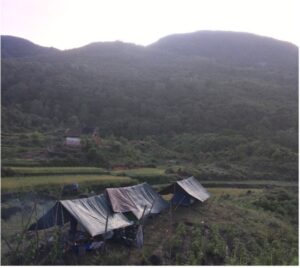

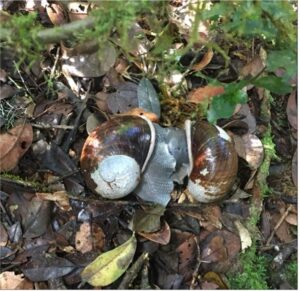

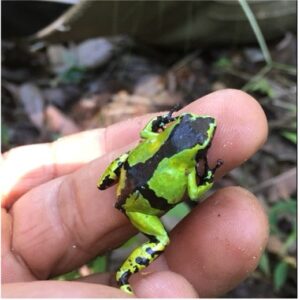
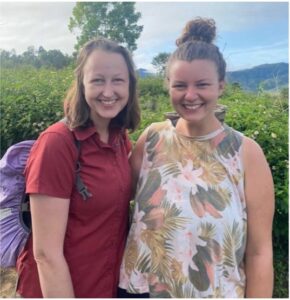
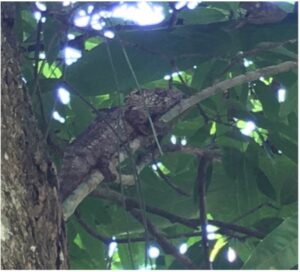
February 2022
Salama,
 This post unfortunately starts out with bad news. Cyclone Batsirai, a Category-4 cyclone, hit southeast Madagascar head-on last weekend (similar to the grading system we use for Atlantic hurricanes). Thankfully, my field team are all ok and Centre ValBio (CVB, research station I work out of) was spared extensive damage. But the local community here in Ranomafana, like hundreds of villages across the region, was decimated from the flooding, landslides, and 245km winds the cyclone brought.
This post unfortunately starts out with bad news. Cyclone Batsirai, a Category-4 cyclone, hit southeast Madagascar head-on last weekend (similar to the grading system we use for Atlantic hurricanes). Thankfully, my field team are all ok and Centre ValBio (CVB, research station I work out of) was spared extensive damage. But the local community here in Ranomafana, like hundreds of villages across the region, was decimated from the flooding, landslides, and 245km winds the cyclone brought.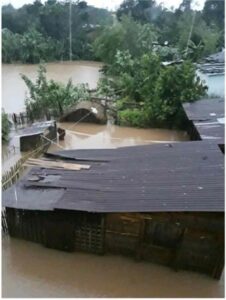 If you’d like to donate to relief efforts, a number of Malagasy NGOs have set up fundraising campaigns such as Centre ValBio itself, Feedback Madagascar (in collaboration with Ny Tanintsika & Blue Ventures), Conservation Fusion, PIVOT, and the Malagasy Red Cross. It has luckily been pretty dry for the post-cyclone week, which has allowed the water levels to come down and for things to start drying up.
If you’d like to donate to relief efforts, a number of Malagasy NGOs have set up fundraising campaigns such as Centre ValBio itself, Feedback Madagascar (in collaboration with Ny Tanintsika & Blue Ventures), Conservation Fusion, PIVOT, and the Malagasy Red Cross. It has luckily been pretty dry for the post-cyclone week, which has allowed the water levels to come down and for things to start drying up.
For context, only twelve category 4 or 5 cyclones have hit Madagascar in the past 110 years. Eight of those have been since 2000, a result of climate change and global warming which increase the frequency, size, and intensity of natural disasters (just like we’ve seen with Atlantic hurricanes, wildfires, tornados, etc. in the US and beyond). Pardon the quick soap-box moment…. Countries who have contributed the least to carbon emissions and climate change (most of those in the Global South) are the ones who bear the brunt of the resulting impacts. The US, Europe, and other Global North countries who have had an outsized effect on global climate change are responsible for mitigating its effects and need to start acting as such.

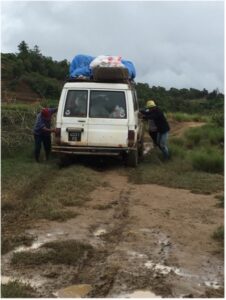 Anyways, prior to the cyclone I was on a 2.5-week expedition to the southern half of the rainforest corridor I am working in (photo dump below). The expedition was to a bad start when our car broke down driving to the corridor, and then ended up stuck in a ditch (it was freed, thanks to the help of ~50 Miarinarivo residents). We got stuck in the mud a lot too (pics to right). When we finally did get to the forest, we ended up having to completely change our expedition plan 4 days in because a series of rainstorms had turned the hill our camp was on into an island. We basically had to evacuate out wading waist-deep through rice-paddies to avoid getting stuck on this “island” for an unknown amount of time. And because of an impassable river in the direction we were supposed to go in, we ended up having to go in the opposite direction. So the next 10 days were completely make-it-up-as-you-go, always fun for a type-A, likes-to-be-in-control person like myself…
Anyways, prior to the cyclone I was on a 2.5-week expedition to the southern half of the rainforest corridor I am working in (photo dump below). The expedition was to a bad start when our car broke down driving to the corridor, and then ended up stuck in a ditch (it was freed, thanks to the help of ~50 Miarinarivo residents). We got stuck in the mud a lot too (pics to right). When we finally did get to the forest, we ended up having to completely change our expedition plan 4 days in because a series of rainstorms had turned the hill our camp was on into an island. We basically had to evacuate out wading waist-deep through rice-paddies to avoid getting stuck on this “island” for an unknown amount of time. And because of an impassable river in the direction we were supposed to go in, we ended up having to go in the opposite direction. So the next 10 days were completely make-it-up-as-you-go, always fun for a type-A, likes-to-be-in-control person like myself…
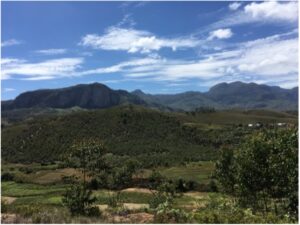 I also got stung by a ghost, I am convinced. I was legit standing still, in a field, and all of a sudden had a dash of pain in my leg. But no flying insects around, no spiny plants, nothing I could find that could have stung me. Hence, I have come to the conclusion it was a ghost wasp. I have never wished more for ice than that day… (it’s all healed now, despite turning my whole thigh red and puffy). It was perhaps the same ghost creature that stole my shampoo & soap, which disappeared halfway through the expedition. They were outside my tent in a bag at night and gone the next morning. So I ended up using dish soap for my euphemistically-named “showers” (it’s a bucket & cup). We of course still managed to find some cool wildlife this trip (see photo dump below), including some brown lemurs who were very angry at our apparent entry into their territory. They came over and screamed at us (literally the call sounds like an animal being choked and throwing up simultaneously) and let me tell you for 3kg animals, they can get mighty ferocious. No fear of humans there apparently.
I also got stung by a ghost, I am convinced. I was legit standing still, in a field, and all of a sudden had a dash of pain in my leg. But no flying insects around, no spiny plants, nothing I could find that could have stung me. Hence, I have come to the conclusion it was a ghost wasp. I have never wished more for ice than that day… (it’s all healed now, despite turning my whole thigh red and puffy). It was perhaps the same ghost creature that stole my shampoo & soap, which disappeared halfway through the expedition. They were outside my tent in a bag at night and gone the next morning. So I ended up using dish soap for my euphemistically-named “showers” (it’s a bucket & cup). We of course still managed to find some cool wildlife this trip (see photo dump below), including some brown lemurs who were very angry at our apparent entry into their territory. They came over and screamed at us (literally the call sounds like an animal being choked and throwing up simultaneously) and let me tell you for 3kg animals, they can get mighty ferocious. No fear of humans there apparently.
 We were out of cell service, so we heard about the cyclone via the radio we brought with us. Mad-dash evacuation number 2. We had a hard time hiring porters to carry our equipment out of the forest to the road, because most villagers were frantically cutting the rice in their paddies for fear of losing all their crops and their supply of this Malagasy food staple. But we did manage to get back to CVB the day before the cyclone hit.
We were out of cell service, so we heard about the cyclone via the radio we brought with us. Mad-dash evacuation number 2. We had a hard time hiring porters to carry our equipment out of the forest to the road, because most villagers were frantically cutting the rice in their paddies for fear of losing all their crops and their supply of this Malagasy food staple. But we did manage to get back to CVB the day before the cyclone hit.
I’m now waiting at CVB for the road we need to take to the forest corridor to clear. Apparently one of the bridges on the road was washed away and is being fixed, so we are waiting to hear from our local contacts and will leave as soon as it’s possible to drive. We’ll be starting back where we left off in the last expedition and getting into the middle section of corridor, pending more cyclones & over-flowing rivers of course…
Stay safe!
– Carly/lemur lady/ghost wasp attractant

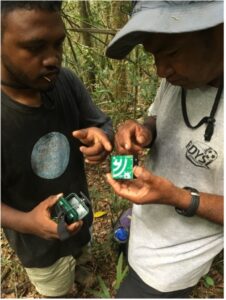
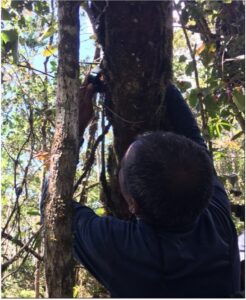
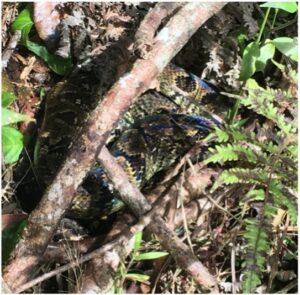

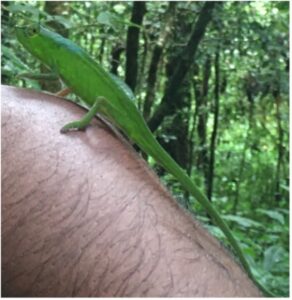


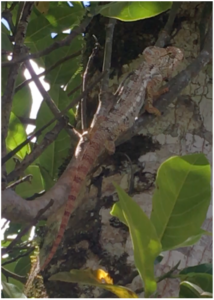
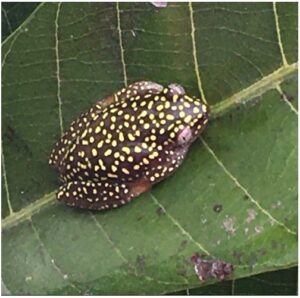
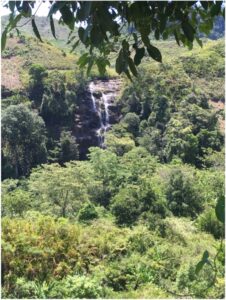
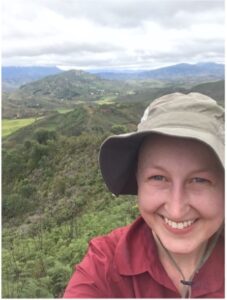

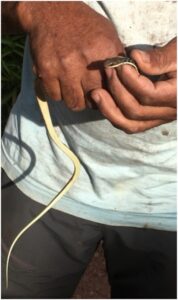
January 2022
Salama!
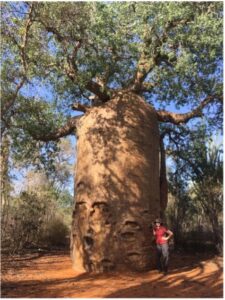
Hope everyone had happy holidays and that the new year is starting off well. The research station I’m based out of (Centre ValBio) had a week off around Christmas so I decided to escape to the coast for a bit & went to the Mozambique Channel (for ONLY Madagascar, I will say west coast is best coast…get out of here if you think it’s the same in the US hehe). Along the way I stopped at some other national parks and reserves and saw some cool animals (King Julian’s friends) and gigantic baobabs (pics to the right, and big big photo dump down below the text)!

But then it was back to work, deploying more of the special sound recorders into new areas of the rainforest corridor I mentioned in the first blog (map in that post). I’ve got a really amazing Malagasy field team working with me (pic below right, enjoy my washed out sweaty field self) – Rija, a Master’s student (seen in pic below deploying a device); Georges, a Centre ValBio research tech; and Solo, who maintains our campsites, keeping the fire going, the water boiled (a must to be able to drink it) and cooking meals in the field. The 5th team member is a local guide from whatever village is closest to the forest site we’re going to, so that person changes every couple days. And then every 2-3 days when we move camp, we hire people from the local village to porter all of our equipment and food. And these people are SO dang strong. 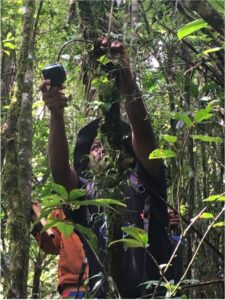 They balance the bags on their heads and then proceed to run up giant mountains like they’re ant hills. And then there’s Carly the vazaha ( Malagasy word for white foreigner) bringing up the rear…
They balance the bags on their heads and then proceed to run up giant mountains like they’re ant hills. And then there’s Carly the vazaha ( Malagasy word for white foreigner) bringing up the rear…
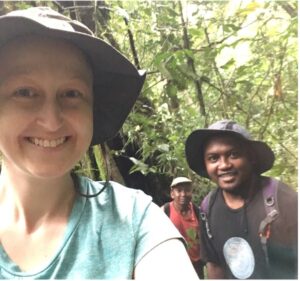
Expeditions now are in the height of the rainy season, and with that comes my arch-nemesis, the leeches (‘dinta’ in Malagasy). These little mini-worm vampire heathens are EVERYWHERE and do a great job getting under your clothes and legit sucking your blood. And even if you pull them off, they inject an anti-coagulant so you keep bleeding for a ridiculously long time given the tiny bite that it is. On top of the bites, my legs are also recovering from bruises that are the result of a lovely fall I took in a river we were crossing. It was deep because of all the rain and I tripped and had one of those grabbing-at-air-because-that-will-definitely-save-you scenes. I got lots of laughs from the local villagers… (I am fine, fear not). Falling in the water hurts less than falling over tree roots in the forest, I know this from extensive personal experience… The vegetation is super thick so as we (read: our guides) bushwhack a trail, opportunities abound for clutzy vazaha to trip (pic below left).

Beyond the fieldwork though, there is still work to be done in between expeditions to process & analyze the recordings that these devices are collecting. We’re talking about terabytes of data, tens of thousands of hours of recordings that would take legit years to manually listen to, and ain’t nobody got time for that. Luckily, we have the wonder that is artificial intelligence (AI). I collaborate with a computer programmer to develop machine learning (ML) models that can automatically go through recordings and pick out the lemur calls (thank the lord). Basically, you give the computer a bunch of examples of the animal vocalization you want it to find, it “trains” itself on these, and then goes through the recordings and tries to find clips that match those examples you gave it. I often refer to this as magic or witchcraft because it seems insane, but this is why I collaborate with programmers who understand the black box of ML a whole lot more than I ever will. We use spectrograms, 2-D visualizations of sounds, as those examples; a ruffed lemur call spectrogram looks like the image below (frequency on y-axis, time on x-axis, color=power intensity). We can then model the lemurs’ distribution based on the calls detected per device and the device’s GPS coordinates.
So there is always something to do, both in the field and back at Centre ValBio. Despite all the hard work, it’s pretty cool to be going to some areas that haven’t been surveyed in decades, if at all, and knowing that the information we’re getting can contribute to conservation efforts. But for now, I’m off in a few days for a 3-week trip. I’ll have plenty more stories then to share for the next post in February! Stay well, y’all.
Carly/lemur lady
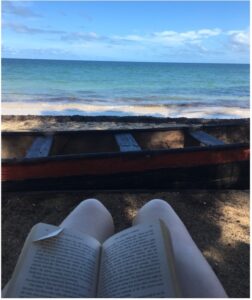

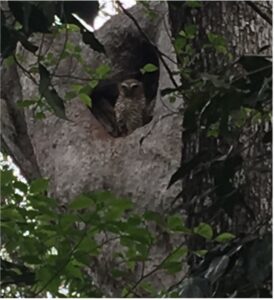

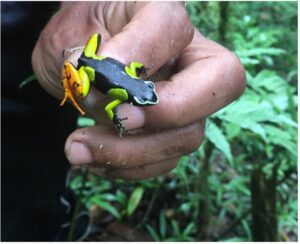






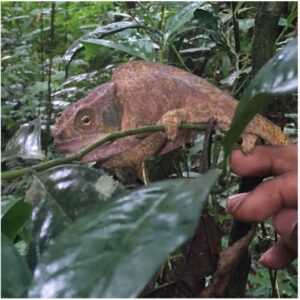
December 2021
Salama! Hello!
I’m Carly, a PhD student at the CUNY Graduate Center in Dr. Andrea Baden’s research group. I wrote from-the-field blog posts the last time I was in Madagascar, which was summer 2019. I had planned to go back to Madagascar the following year, but….COVID hit and Madagascar closed its borders until November 2021, when I was finally able to get back here. (And just in time, as I ended up having to move back in with my parents during the pandemic and we were about ready to punch each other). I’m lucky to be funded by a Fulbright fellowship for this fieldwork trip, which I was awarded last year. Fulbright is an international education exchange program housed within (& funded by) the US Department of State. #ThanksUncleSam. If all goes well I’ll be in Madagascar through June 2022, which would be 7 months, a welcome reprieve from the dumpster fire that is the real world right now.

Brief rundown of my project’s change from the 3-month pilot study (basically a trial-and-error run) in 2019 to now… In 2019 I did research on black-and-white ruffed lemurs (pic on left) at a site my advisor runs in Ranomafana National Park called Mangevo. The ruffed lemurs there are radio-collared so we can find them and individually identify them. I was studying their vocal communication, the calls they make. Basically trying to speak lemur. This involved recording the calls with a specialized microphone/recorder unit and also doing behavioral observations to see what behaviors were before and after different call types, if certain groups differed in which call types they used, etc. (For the academics – I just published a paper on this!)
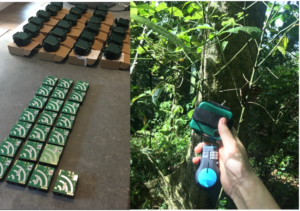
I am now pivoting a bit and using lemur calls for a more applied purpose, the fancy name being passive acoustic monitoring. Essentially what this means is using specialized recorders (pic on right) that you put up and then can run for weeks or months at a time. You then go through these recordings looking for vocalizations from a specific species of interest (ruffed lemurs in my case) and can use these detections to assess the presence, distribution and relative abundance of a species without needing people on the ground (which saves precious time, labor & money). I’m using passive acoustic monitoring within a rainforest corridor that connects two national parks (see map below). We don’t know really know the distribution of ruffed lemurs within the corridor, and there haven’t been systematic surveys of really any animal group there in decades.
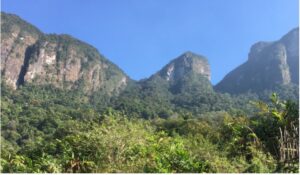
As I’m quickly learning, there’s a reason for this. The places we’re going are incredibly remote and the terrain is very difficult, basically forests on top of cliffs that take some amount of hours of driving + days of hiking to reach (pic to left). I’ve just finished my first few camping expeditions into the corridor and man have I pushed my leg muscles to the brink. Everything is somehow uphill. The Malagasy word for ‘up’ or ‘top’ is ‘ambony’ or ‘miakatra.’ I use these words way. too. often. No amount of peloton’ing or running can prepare your body for this terrain. Have I mentioned it’s also the hot/wet season so we’ve also go 90°+ weather and the ever-present threat of thunderstorms and monsoons. And naturally, the girl who uber-sensitive skin that reacts to everything and anything has chosen fieldwork as a profession. So it’s a good bet at any time that I’m in a Bendaryl-induced haze (it doesn’t make me fall asleep though, thankfully) and lathered in cortisone cream. Don’t tell my nurse sister…
We’re also having to establish collaborations with local communities who have not had vazaha (Malagasy word for white foreigners) working there in decades, if at all. The logistics of all this is the not fun part. We’ve literally had to wander aimlessly around villages asking very confused people who the president is and where we can find him to get permission to go into the community-managed forests and set up our camps (tent pic on right is my ‘home’).
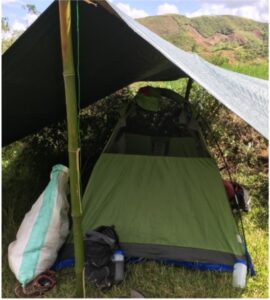
Fieldwork, I tell ya. Simultaneously the most challenging and rewarding time. Stay tuned for more updates and #FieldworkFails. In the next blog post I’ll talk a bit about how I’m using magic (read: AI and machine learning) to analyze these tens of thousands of hours of sound recordings that passive acoustic monitoring yields. For now, happy holidays to you all! Here’s hoping the new year is better than the last (and the one before that too ideally).
– Carly (or lemur lady, as my family loves to call me)

This blog is not an official site of the Fulbright Program or the U.S. Department of State. The views expressed on this site are entirely those of its author and do not represent the views of the Fulbright Program, the U.S. Department of State, or any of its partner organizations.



